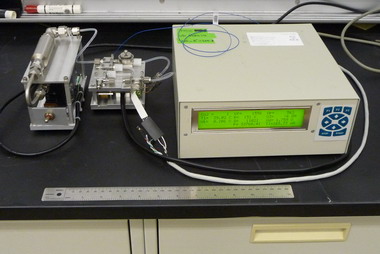QEPAS (Quartz
Enhanced Photoacoustic Spectroscopy) kits
and complete systems
Control and Data processing
systems for Diode Laser Spectroscopy
QEPAS is a novel
photoacoustic gas detection technique. The key QEPAS feature - using
the high-Q quartz resonator as the acoustic signal detector instead of
the conventional microphone. This gives new advantages to classic
photoacoustic detection principles:
- Zero baseline drift for hours
- Miniature size of the absorption detection module
(ADM)
- Superior absorption sensitivity per unit optical path
length among all detection methods
- Absence of the adjustable elements in the ADM
- High dynamic range (from ppb level to 100%
concentrations)
- The sensitivity is the same as for classic laser
photoacoustic spectroscopy technique
- Low sensitivity to external acoustic noise
- Ultra small gas volume in the sensing element - near
1 mm3
The QEPAS ADM module.
The NNEA (Normalized noise equivalent absorption) for NH3 at
1.53 um is 3.3·10-9 cm-1W/Hz-1/2.
Ammonia
detection
limit
in
the air - 25 ppb for 10 second
integration time.
QEPAS method was invented by A.A.Kosterev at RICE
Quantum Institute in 2002, and then developed in close cooperation with
CDP Systems Corp.

QEPAS gas detector at
RICE. CDP Systems QEPAS Control unit (right), gas inlet system (left).
Photo by A.A.Kosterev
CPD Systems produces various types of control units for
multispecies QEPAS measurements. The control unit includes DFB or QCL
laser
driver with precision temperature control, low noise modulation signal
syntesizer, laser frequency stabilization loop with reference gas
cells, 24-bit high-speed ADC, digital lock-in and data logging flash.
Each control unit can support up to 4 reference cells
with different gases, one main and 3 additional DFB laser source (or a
multichip DFB laser with SOA) and 2 ADM.
Control unit also supports the external Quantum Cascade
(QC) mid-IR laser in AM (detection on modulation frequency) and
FM (detection on second acoustic harmonic) modes.
The device can be programmed for up to 10 different
consecutive measurement modes (laser selection, laser current and
temperature, ADM and reference cell selection, absorption line locking
mode, MEMS optical switch state, etc.) for different species detection.
The control unit periodically performs automatic zero
and ADM parameters (Q-factor, loss resistance, resonant
frequency) calibration.
Specifications:
- ADM tuning fork frequency range: 5000 - 50 000 Hz
- ADM tuning fork Q-factor: 700 - 150 000
- Supports DFB lasers in butterfly and TO (optional)
cases
- Maximum internal and external DFB lasers current: 600
mA
- Maximum internal QCL laser current: 1500 mA
- Laser chip temperature range: -10 +40 °C
- Acoustic signal detection at ADM thermal noise limit
- Power supply: universal AC or rechargeable Li-ion
cells with the external AC adapter (6+ hours of autonomous work)
- Computer interface: serial/USB, protocol compatible
with LabView® programming environment
- Humidity and temperature sensors for monitoring
the gas properties
- Programmable operation modes: 10
- Supports up to 4 DFB laser sources in one
configuration
Please, send your
questions and requests to qepas@cdpsystems.com for faster response. |

